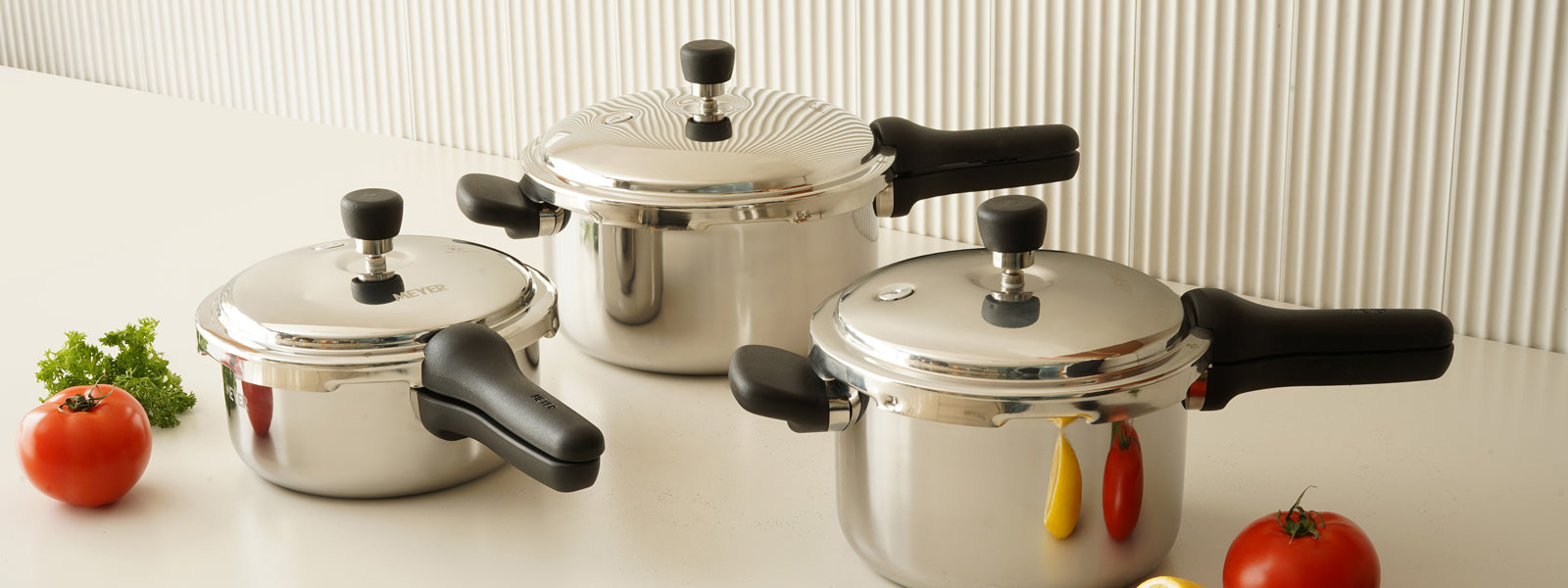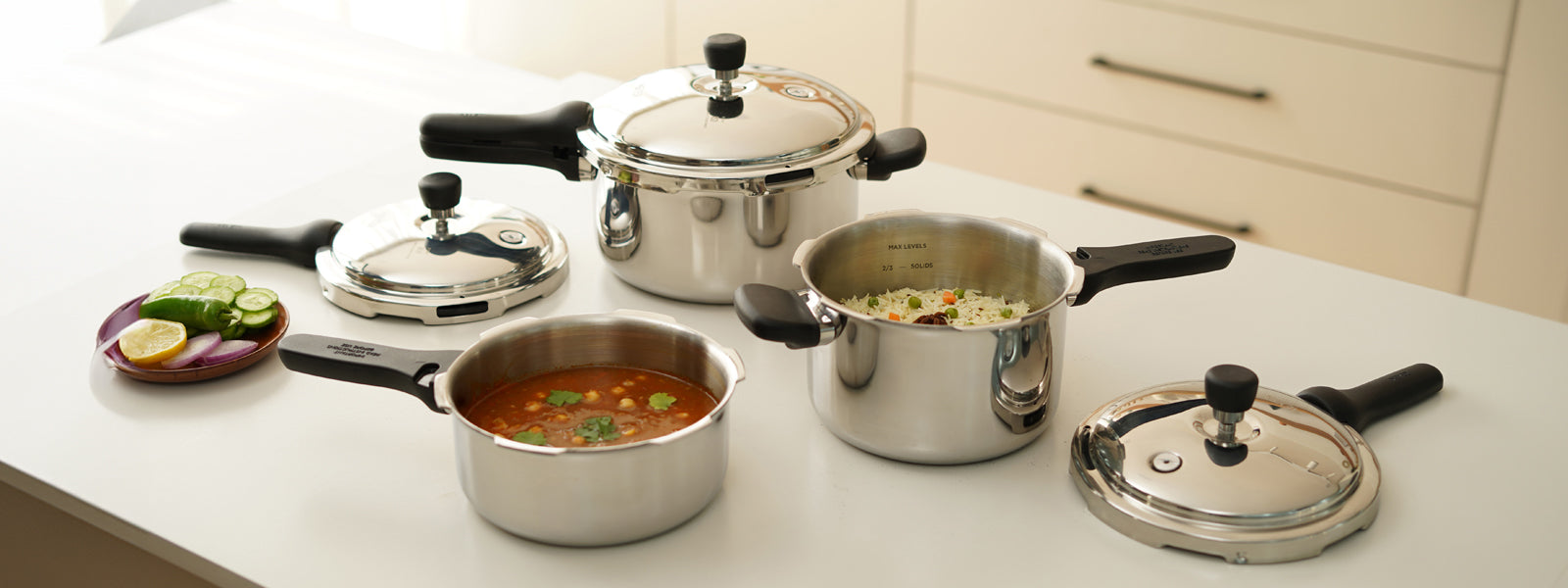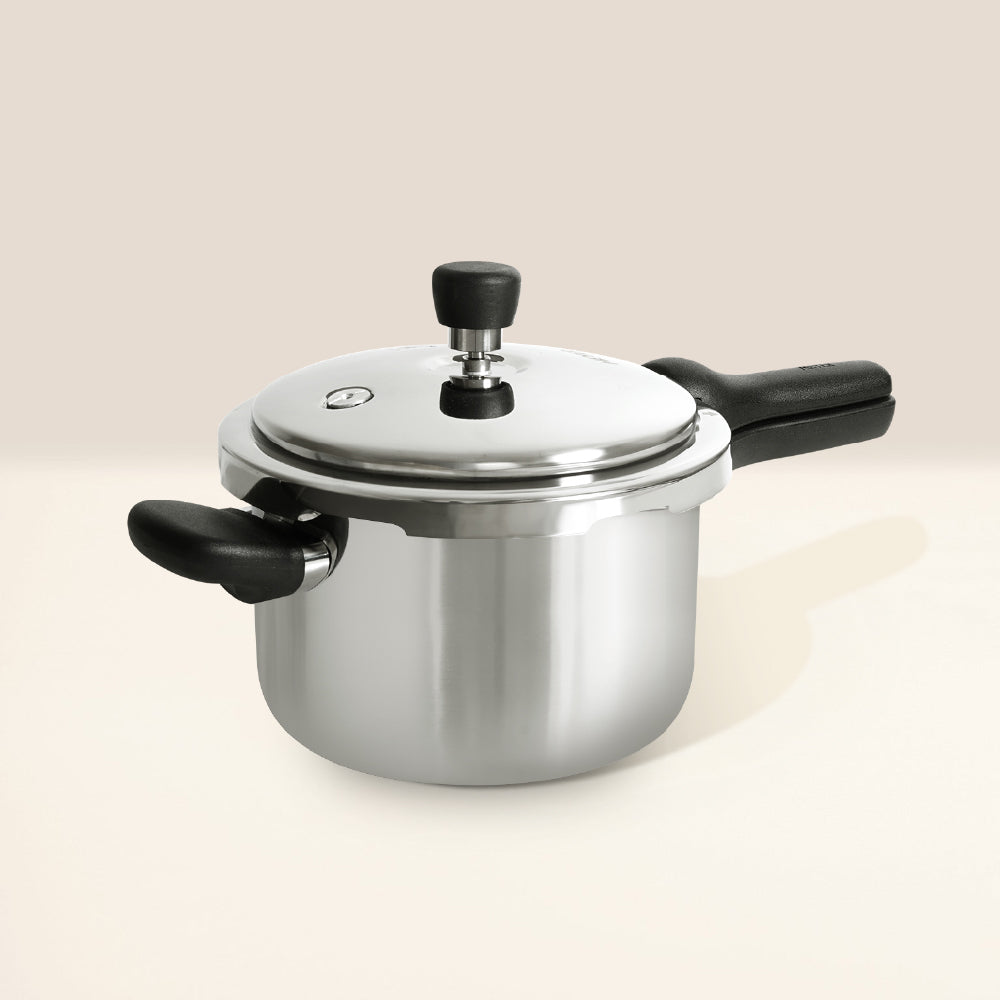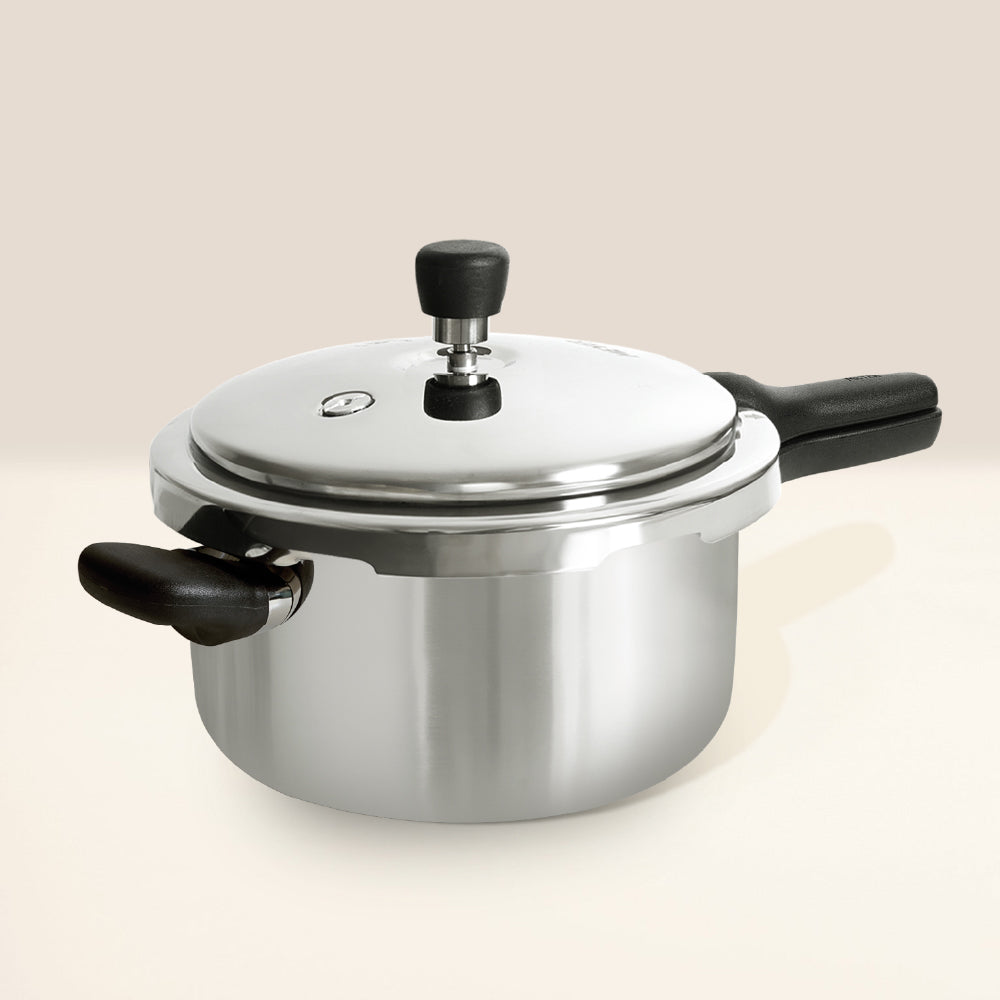Preserving food is a great way to enjoy seasonal produce all year round and to reduce food waste. One effective method for preserving food is pressure canning, which uses a pressure cooker to process foods in a sealed jar. Pressure canning is a safe and reliable way to preserve a wide range of foods, including fruits, vegetables, meats, and soups. In this post, we will explore how pressure cookers can be used for preserving and canning food, the benefits of pressure canning, and some tips and tricks to get you started.
Table of Contents
- I. Introduction
- II. The Basics of Pressure Canning
- III. The Importance of Safety in Pressure Canning
- III. Using Pressure Cookers for Pressure Canning
- IV. How to Pressure Can with a Pressure Cooker
- V. Safety Tips for Pressure Canning with a Pressure Cooker
- VI. Recipes and Ideas for Pressure Canning with a Pressure Cooker
- VII. Conclusion
MEYER Presta Tri-ply with Outer Lid Pressure Cooker 3L
I. Introduction
In recent years, there has been a growing interest in preserving and canning food as a way to reduce waste and have access to fresh, homemade meals throughout the year. While traditional methods such as pickling and fermenting have been around for centuries, pressure cooking has become a popular and efficient way to preserve food in modern times. In this post, we'll explore the benefits of using pressure cookers for preserving and canning food, as well as some tips and techniques for getting started. Whether you're an experienced canner or new to the process, this post will provide valuable insights into how pressure cookers can revolutionize your food preservation game.
II. The Basics of Pressure Canning
Pressure canning is a safe and efficient method of preserving food that requires the use of a pressure canner, a specialized cooking vessel that maintains a high level of pressure and temperature. In this section, we will discuss the key aspects of pressure canning, including how it works and its benefits.
A. What is pressure canning and how does it work?
Pressure canning is a process of preserving food in airtight containers, such as jars, by subjecting them to high pressure and temperature. This process destroys harmful bacteria, such as botulism that can cause foodborne illness and spoilage.
The pressure canner works by creating a seal around the jars and then raising the temperature and pressure inside the canner. The high pressure and temperature inside the canner kill bacteria and create a vacuum seal around the jar, which prevents the entry of any new bacteria or contaminants.
B. The benefits of pressure canning for food preservation
Pressure canning offers several benefits over other methods of food preservation, such as water bath canning or freezing. These benefits include:
- Longer shelf life: Properly canned food can last for several years without spoilage or loss of quality. This makes it an ideal method for preserving seasonal produce or stockpiling food for emergencies.
- Nutrient retention: Pressure canning preserves the nutritional value of food by exposing it to high temperatures for a shorter period of time than other preservation methods.
- Versatility: Pressure canning can be used for a wide range of foods, including fruits, vegetables, meats, and soups.
- Cost-effective: Pressure canning allows you to preserve food at home, reducing the need to buy expensive canned goods from the store.
Overall, pressure canning is a safe, effective, and versatile method of preserving food that can help you save money, reduce food waste, and stock up on healthy, nutritious food for your family.
III. The Importance of Safety in Pressure Canning
Pressure canning is a great way to preserve food for long-term storage, but it is essential to follow proper safety guidelines to prevent the growth of harmful bacteria and other pathogens. Here are some important safety considerations to keep in mind when pressure canning:
The risks of improper canning practices: Improper canning techniques can lead to the growth of bacteria, such as Clostridium botulinum, which can cause serious illness or even death if consumed. It is important to follow reliable recipes and guidelines for canning and to avoid shortcuts or improvisation.
Key safety guidelines for pressure canning: To ensure the safety of your canned food, it is essential to follow these guidelines:
Always use tested and approved canning recipes from reputable sources.
Follow the recipe and processing times carefully.
- Use the appropriate canning equipment, including jars, lids, and a pressure canner.
- Check the condition of the jars and lids before use and discard any that are cracked or damaged.
- Use the correct pressure and processing time for your altitude and type of food.
- Allow the canner to vent steam for the recommended time before placing the weight on the vent pipe.
- Monitor the pressure canner during the processing time to ensure it maintains the proper pressure.
- Let the canner cool down naturally before removing the jars.
- Store the canned food in a cool, dark place and discard any jars that show signs of spoilage or damage.
By following these guidelines, you can safely and effectively preserve your food using a pressure canner. Remember, taking shortcuts or deviating from recommended canning practices can put you and your family at risk, so it is always better to err on the side of caution.
III. Using Pressure Cookers for Pressure Canning
If you're looking to can your own food at home, pressure canning with a pressure cooker is a great way to do it. Here are some advantages of using pressure cookers for pressure canning:
Advantages of using pressure cookers for pressure canning:
- Faster processing time: Pressure canning with a pressure cooker takes less time than other canning methods, such as water bath canning, because the pressure cooker can reach higher temperatures and create a more sterile environment.
- Increased safety: Pressure canning with a pressure cooker reduces the risk of bacterial growth and contamination, which is particularly important when canning low-acid foods such as meats, vegetables, and soups.
- Better preservation of nutrients: Pressure canning with a pressure cooker helps retain more nutrients in your canned food than other canning methods because it cooks food quickly and at high temperatures.
- More versatility: Pressure cookers can be used for both pressure canning and regular cooking, making them a great investment for your kitchen.
Types of pressure cookers suitable for pressure canning:
Not all pressure cookers are suitable for pressure canning. When selecting a pressure cooker for pressure canning, make sure it is designed for this purpose and meets the following criteria:
- Can hold at least 4-quart jars or 7-pint jars
- Can reach and maintain a pressure of 10-15 psi
- Has a pressure gauge for accurate monitoring of pressure
- Has a safety valve to release excess pressure
Comparison with other canning methods:
While pressure canning with a pressure cooker offers many benefits, it is important to note that other canning methods such as water bath canning and steam canning may be more suitable for certain foods. It is important to do your research and follow tested recipes to ensure safe and effective canning.
IV. How to Pressure Can with a Pressure Cooker
Pressure canning is a great way to preserve food at home for later use, and using a pressure cooker can make the process even more efficient. Here are the basic steps for pressure canning with a pressure cooker:
Gather the necessary equipment: To pressure can with a pressure cooker, you will need a pressure cooker with a pressure gauge, canning jars with lids and bands, a jar lifter, a canning funnel, and a bubble remover.
Prepare your food for canning: Follow a tested recipe for your chosen food, and prepare it as instructed. Be sure to wash your jars, lids, and bands in hot soapy water, and sterilize them by boiling in water for 10 minutes.
Fill your jars: Use a canning funnel to fill your jars with the prepared food, leaving the recommended amount of headspace at the top. Use a bubble remover to remove any air bubbles from the jars.
Place the lids and bands on the jars: Wipe the rims of the jars with a clean damp cloth, then place the lids and bands on the jars. Tighten the bands until they are snug but not overly tight.
Place the jars in the pressure cooker: Fill your pressure cooker with the recommended amount of water, and place the jars inside. Be sure to follow the instructions for your specific pressure cooker model.
Process the jars: Secure the lid of the pressure cooker and heat it on high heat until steam starts to escape from the vent. Allow the steam to escape for 10 minutes, then close the vent and allow the pressure to build to the recommended level for your altitude. Process the jars for the recommended amount of time, and then turn off the heat.
Allow the pressure to naturally release: Once the pressure has come down to zero, wait an additional 10 minutes before opening the lid. Carefully remove the jars with a jar lifter and place them on a towel to cool.
Check the seals: After 12 to 24 hours, check the seals on the jars by pressing down on the center of each lid. If the lid is firm and does not pop up and down, the jar is properly sealed. If a jar did not seal properly, it should be refrigerated and used within a few days.
By following these steps and proper safety guidelines, you can safely pressure can a variety of foods with a pressure cooker.
Equipment needed for pressure canning:
- Pressure canner: Make sure you have a pressure canner that is suitable for pressure canning.
- Canning jars: Choose canning jars that are specifically designed for canning and are free of chips or cracks.
- Canning lids and rings: Use new lids and rings for each canning session.
- Canning funnel: A canning funnel makes it easier to fill jars without making a mess.
- Jar lifter: A jar lifter is used to safely remove hot jars from the canner.
Preparing food for pressure canning:
- Choose fresh, high-quality ingredients.
- Follow a tested recipe from a reputable source.
- Wash and prepare the food according to the recipe instructions.
Step-by-step guide for pressure canning with a pressure cooker:
- Prepare the pressure canner according to the manufacturer's instructions.
- Fill the canning jars with the prepared food, leaving the recommended headspace.
- Wipe the rims of the jars clean and apply the lids and rings.
- Place the jars in the pressure canner according to the manufacturer's instructions.
- Close the lid and follow the manufacturer's instructions for venting and building pressure.
- Process the jars for the recommended time at the recommended pressure.
- Turn off the heat and let the canner depressurize naturally.
- Open the lid carefully and remove the jars with a jar lifter.
- Let the jars cool a
- nd check the seals before storing.
V. Safety Tips for Pressure Canning with a Pressure Cooker
Importance of following safety guidelines for pressure canning:
Pressure canning involves high pressure and high temperatures, which can be dangerous if not done correctly. It is important to follow the manufacturer's instructions and use tested recipes from reputable sources.
Common mistakes to avoid:
- Overfilling jars: Leave the recommended headspace to allow for expansion during processing.
- Using improper equipment: Use a pressure canner that is specifically designed for pressure canning.
- Not following the recommended processing time: Processing times are based on the size of the jars and the type of food being canned.
- Not checking the seals: After the jars have cooled, check the seals by pressing on the center of the lid.
VI. Recipes and Ideas for Pressure Canning with a Pressure Cooker
When it comes to pressure canning with a pressure cooker, the options are endless. Here are a few ideas to get you started:
Soups and stews: Pressure canning is an excellent way to preserve homemade soups and stews. From hearty beef and vegetable stew to creamy tomato soup, there are plenty of delicious recipes to choose from.
Fruits and vegetables: Fresh fruits and vegetables can be preserved with a pressure cooker. For example, you can pressure can fresh tomatoes, green beans, and peaches to enjoy them year-round.
Pickles: Pickling is a great way to preserve cucumbers, carrots, and other vegetables. By pressure canning your pickles, you can ensure that they are safe to eat and will last for months.
Jams and jellies: If you have an abundance of fresh fruit, consider making jams and jellies that can be preserved with a pressure cooker. Strawberry jam, peach jam, and grape jelly are just a few examples of delicious preserves that can be made with a pressure cooker.
VII. Conclusion
Pressure canning with a pressure cooker is a great way to preserve food and save money. By following the proper safety guidelines and using high-quality equipment, you can safely can a wide variety of foods. With a little bit of practice, you'll be able to stock your pantry with delicious homemade meals and snacks that can be enjoyed year-round. So why not give pressure canning a try and see how it can benefit you and your family?
MORE FROM BLOG
Top Collections
A Guide to Different Types of Pressure Cookers: From Multi-Cookers to Canning Pressure Cookers
2 Items











Leave a comment